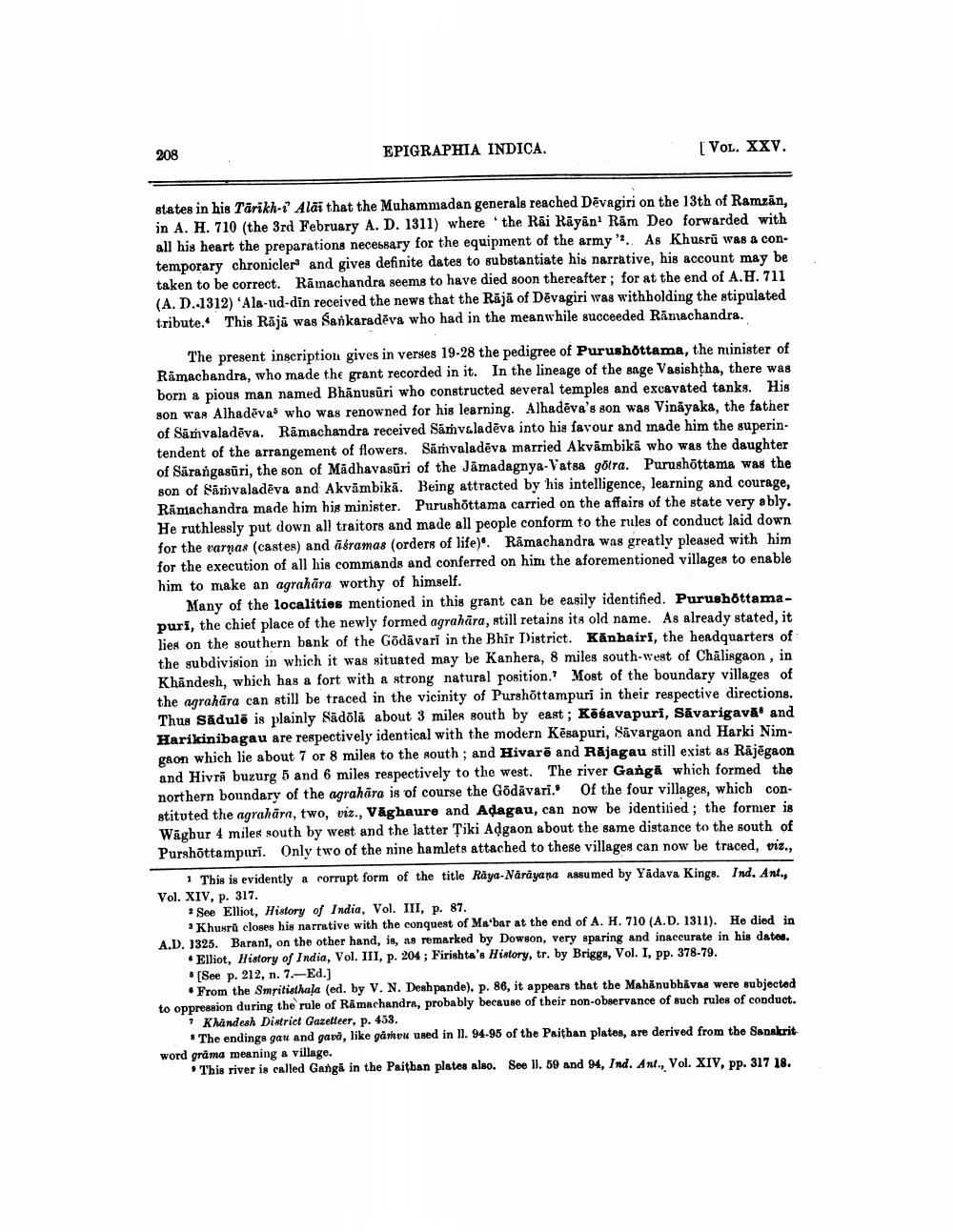________________
208
EPIGRAPHIA INDICA.
[Vol. XXV.
states in his Tarikh-i Alai that the Muhammadan generals reached Dēvagiri on the 13th of Ramzan, in A. H. 710 (the 3rd February A. D. 1311) where the Rāi Rāyan Ram Deo forwarded with all his heart the preparations necessary for the equipment of the army'. As Khusrü was a contemporary chronicler and gives definite dates to substantiate his narrative, his account may be taken to be correct. Ramachandra seems to have died soon thereafter; for at the end of A.H. 711 (A. D..1312) 'Ala-ud-din received the news that the Räjā of Dēvagiri was withholding the stipulated tribute. This Rāja was Sankaradeva who had in the meanwhile succeeded Ramachandra.
The present inscription gives in verses 19-28 the pedigree of Purushottama, the minister of Ramachandra, who made the grant recorded in it. In the lineage of the sage Vasishtha, there was born a pious man named Bhanusuri who constructed several temples and excavated tanks. His son was Alhadēvas who was renowned for his learning. Alhadēva's son was Vinayaka, the father of Sāṁvaladēva. Ramachandra received Samvela dēva into his favour and made him the superintendent of the arrangement of flowers. Samvaladēva married Akvämbika who was the daughter of Sārangasūri, the son of Madhavasūri of the Jāmadagnya-Vatsa göra. Purushottama was the son of Sārvaladēva and Akvämbikā. Being attracted by his intelligence, learning and courage, Ramachandra made him his minister. Purushottama carried on the affairs of the state very ably. He ruthlessly put down all traitors and made all people conform to the rules of conduct laid down for the varnas (castes) and asramas (orders of life)". Ramachandra was greatly pleased with him for the execution of all his commands and conferred on him the aforementioned villages to enable him to make an agrahāra worthy of himself.
Many of the localities mentioned in this grant can be easily identified. Purushottamapuri, the chief place of the newly formed agrahāra, still retains its old name. As already stated, it lies on the southern bank of the Godāvari in the Bhir District. Kānhairi, the headquarters of the subdivision in which it was situated may be Kanhera, 8 miles south-west of Chālisgaon, in Khāndesh, which has a fort with a strong natural position. Most of the boundary villages of the agrahāra can still be traced in the vicinity of Purshottampuri in their respective directions. Thus Sadulē is plainly Sādõlă about 3 miles south by east; Kēsavapuri, Săvarigavāand Harikinibagau are respectively identical with the modern Kēsapuri, Săvargaon and Harki Nimgaon which lie about 7 or 8 miles to the south; and Hivarē and Rājagau still exist as Rājēgaon and Hivră buzurg 5 and 6 miles respectively to the west. The river Gangā which formed the northern boundary of the agrahāra is of course the Godavari. Of the four villages, which constituted the agrahāra, two, viz., Vāghaure and Adagau, can now be identitied; the former is Waghur 4 miles south by west and the latter Tiki Adgaon about the same distance to the south of Purshottampuri. Only two of the nine hamlets attached to these villages can now be traced, viz.,
1 This is evidently a corrupt form of the title Rāya-Narayana assumed by Yadava Kings. Ind. Ant., Vol. XIV, p. 317.
? See Elliot, History of India, Vol. III, p. 87.
Khusrü closes his narrative with the conquest of Ma'bar at the end of A. H. 710 (A.D. 1311). He died in A.D. 1325. Barani, on the other hand, is, as remarked by Dowson, very sparing and inaccurate in his dates.
• Elliot, History of India, Vol. III, p. 204 ; Firishta's History, tr. by Briggs, Vol. I, pp. 378-79.
[See p. 212, n. 7.-Ed.]
. From the Smritisthala (ed. by V. N. Deshpande). p. 86, it appears that the Mahanubhāvas were subjected to oppression during the rule of Ramachandra, probably because of their non-observance of such rules of conduct.
7 Khandesh District Gazetteer, p. 453.
The endings gaw and gavā, like gårhuu used in 11. 94-95 of the Paithan plates, are derived from the Sanskrit word gräma meaning a village.
• This river is called Gangă in the Paithan plates also. See II. 59 and 94, Ind. Ant., Vol. XIV, pp. 317 18.




